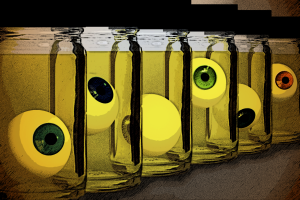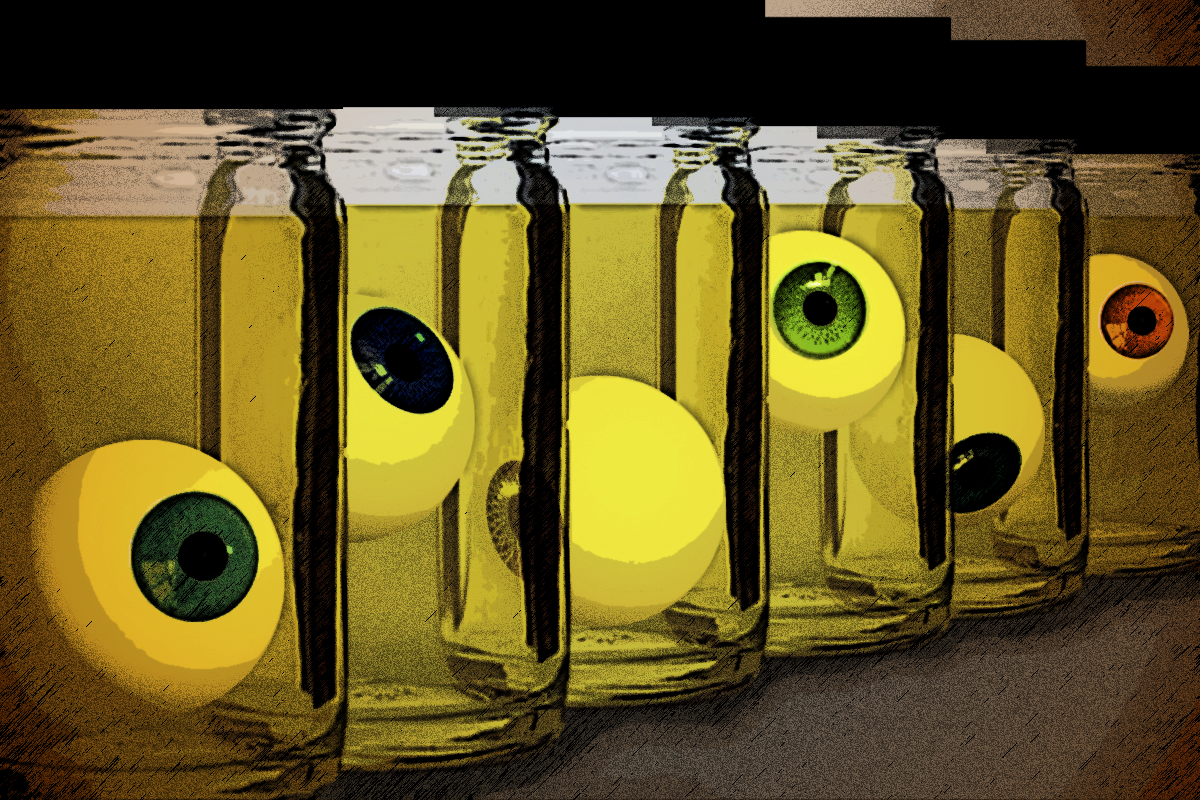An essay by Ivan Gorr, as provided by Diana Parparita
Art by Scarlett O’Hairdye
My name is Ivan Gorr, and I’ve been, perhaps, the key contributor to Project Eve, though, as my lack of an academic background might suggest, I was not one of the researchers working on the project. I was employed by Neogenesis Labs as a janitor, a task still considered to require human intelligence over mechanized precision, due in part to the inventive hiding places that the residues of a genetic lab might find under the furniture, and in part to the twenty-hour workdays that some scientists subjected themselves to, making cleaning their labs a difficult to time operation that required a tactful, humane approach that the cleanbots currently on the market simply cannot emulate. My email address, consisting, according to company regulations, of the initial of my first name followed by my last name in full, instantly attracted the attention of every employee who had some form of business requiring urgent communication with the janitorial department, whether it was to announce a surge in biochemical waste that needed instant removal or to request a fresh supply of body bags, and within a week of my arrival at Neogenesis, I was known throughout the compound and hailed everywhere I went as “Igor.”
The employees at Neogenesis certainly do have a penchant for humorous nicknames and I wasn’t the first to be thus christened by them. Dr. Francine Stein, for instance. The eminent geneticist in charge of Project Eve, was known to her colleagues as Dr. Frankenstein, while the project she was heading was only ever referred to as “Frankenstein’s Monster,” which, I believe, was the staff’s own take on the non-disclosure agreement we had all signed, down to the last and lowliest janitor, to protect the secrecy of the project until Neogenesis would announce it publicly.
I was fascinated by Dr. Stein from the very beginning. In those days, she was already in her early forties, and a highly respected member of the international scientific community. She was one of those scientists who worked impossible hours, and junior staff under her command frequently resigned or pleaded to be transferred elsewhere after mere weeks of trying to keep up with her schedule. She was invariably pale and invariably tired, living exclusively inside her lab, sleeping in her chair, surviving on coffee and dietary supplements and showering in the antiseptic decontamination chamber on the 5th floor. During the day, when other employees were around, she wore her lab coat buttoned up and her hair in a bun tied so tightly that it pulled at her skin, stretching her face into an impenetrable mask. At night, when she thought no one was around, she’d take off her shoes and unbutton her lab coat and loosen her hair, letting it flow over her shoulders in a cascade of chestnut-brown curls.
Back in those days, the project certainly seemed to deserve its name as Frankenstein’s monster. The lab was always full of body parts, carefully tagged and dissected and measured inside-out. They studied them in batches: feet, legs, arms, hands, torsos. In the end, it was eyeballs. There were thousands of them, preserved in tiny jars with bar-code stickers on them, ordered into neat collections on the shelves, color-coded. It was a collection any serial-killer would have died for, and there weren’t two of them alike. Small and round as they were, they often got lost, hiding under the furniture or in dark corners of shelves and drawers until the smell would give them away. For weeks I chased them over the floor, crawling on all fours under Dr. Stein’s desk, brushing my hand against her ankle to get to one sample or other that had rolled into oblivion under her chair. And for weeks I saw her studying her collection of samples, at first with interest, then hope, then a sort of impatience that gave way to irritation. I’d expected she’d move on to another body part soon and discard her samples as she’d discarded the hands and the arms and the legs and the feet and all other parts, but months went by and she was still hoarding eyeballs, until every space was taken up by their little jars. Late at night, when I was silently sweeping the dust while she slept in her chair, surrounded by all those disembodied eyeballs, I felt I was being watched.
#
The project was stalling. Assistants got reassigned. Higher-ups began coming into the lab to talk to her.
“You have made tremendous discoveries,” they’d say, trying to look away from the jars. “Thanks to your research, we now know more about the human genome than we ever thought possible. And the scientific community would greatly benefit from this wealth of information if you would only complete your project and publish your results.”
“This is my baby!” Dr. Stein would say sharply, her face tightened by the pull of her neatly bound hair.
“We know it is your baby, of course. And we value your commitment to the project. But eye color just isn’t important enough to justify the funds wasted by this delay. We must insist that you proceed to the next phase. Even at the projected pace, it would take years before we can show any results to the general public. Our shareholders are anxious. And without any progress to report, it has been increasingly difficult to find donors …”
“You bribe your donors!” Dr. Stein spat back. “Just bribe more of them!”
“We offer a small token of our appreciation to the relatives of the deceased for donating the bodies of their loved ones to science, yes,” the higher-ups would say tactfully. “But our shareholders believe too much appreciation has been put into your project already.”
Dr. Stein would always find a way to get them out of her hair without actually promising to move on with the project, and the higher-ups would always walk out of the lab in a foul mood.
“Women!” they’d say to each other, rolling their eyes as they walked down the corridor. “They’re never happy. Does she even know what she wants?”
“Does it even exist?”
“If it doesn’t exist, she can make it, I’ll give her credit for that. If she wanted the prototype to have bubblegum-pink eyes with little blue stars in them, she could engineer a gene for that. And we’d make a fortune just on the publicity we’d be getting from that sort of thing. But she doesn’t want that, no, she wants to find the right eyes. She wants everything nice and natural, no enhancements, just ‘natural’ pieces of ‘real’ DNA taken from actual, real-live people. Well, actual real-dead people anyway. And it’s going to be one actual real-dead project if she doesn’t make up her mind soon.”
Sometimes I worried that they’d really shut down the project, that they’d send her packing and give the lab to some stuffy old man and I’d never see her again. But, whatever it was that she did, she seemed to be the only one who could get the project through, and they’d spent too much money on it already to pull the plug now, without reaping any benefits. Still, they cut back on the funding and, as I watched her all alone in her lab, frowning at the same old samples and muttering to herself as she went over them again and again, I began to fear for her sanity.

In the end, it was eyeballs. There were thousands of them, preserved in tiny jars with bar-code stickers on them, ordered into neat collections on the shelves, color-coded. It was a collection any serial-killer would have died for, and there weren’t two of them alike.
To read the rest of this story, check out the Mad Scientist Journal: Summer 2015 collection.
Ivan Gorr is manager of the janitorial department at Neogenesis Labs.
Diana Parparita’s stories have appeared in Allegory, Enchanted Conversation, Bards and Sages Quarterly, Swords and Sorcery Magazine, Mad Scientist Journal, and Avast, Ye Airships!
Scarlett O’Hairdye is a burlesque performer, producer and artist. To learn more, visit her site at www.scarlettohairdye.com.
Follow us online: